Nothing is causing more confusion, frustration, squabbles, duels, divorce, facebook “unfriending”, and countless other disasters than the current state of North American Ratsnake taxonomy. I will keep this short, concise, and (hopefully) easy for any one to understand.
Once upon a time there existed a snake known as the “Common Ratsnake” (Elaphe obsoleta). This snake was divided into five subspecies ;
Black Ratsnake (Elaphe obsoleta obsoleta)
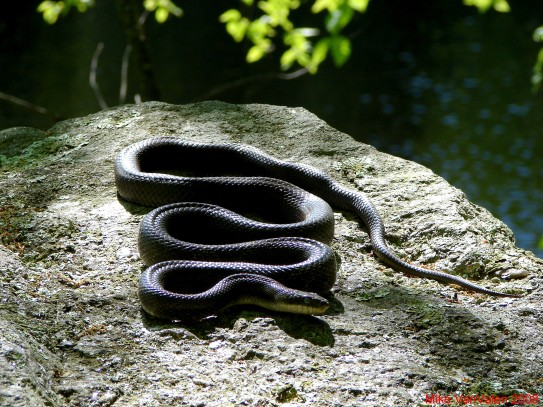
Gray Ratsnake (Elaphe obsoleta spiloides) – photo courtesy of Christy Eddy
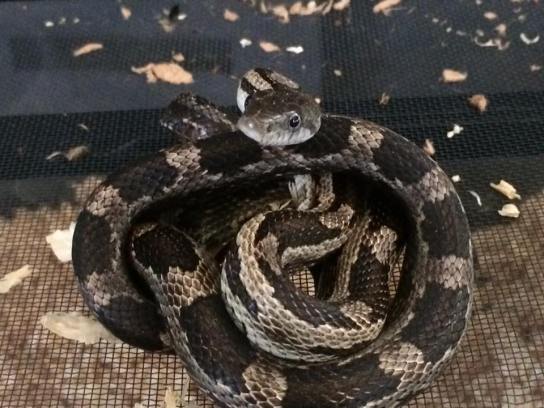
Yellow Ratsnake (Elaphe obsoleta quadrivittata) – photo courtesy of Luke Smith

Texas Ratsnake (Elaphe obsoleta lindheimeri) – photo courtesy of Adrian and Laura Berg
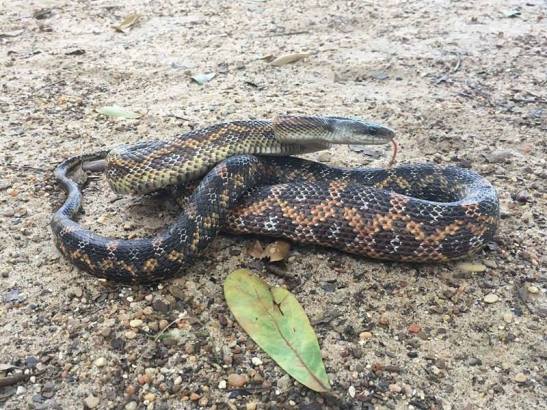
Everglades Ratsnake (Elaphe obsoleta rossalleni) – photo courtesy of Michael Taylor
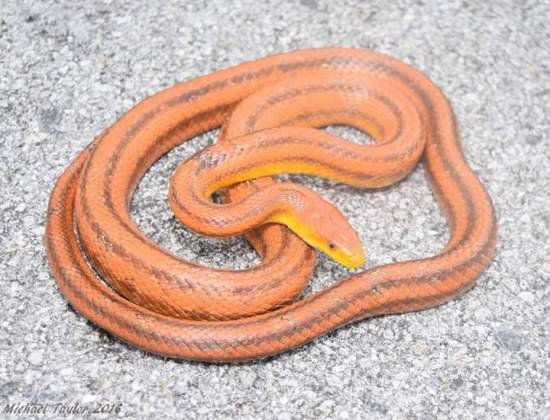
Then some taxonomists came along and said, “Hey, I think we’ll change the genus of North American Ratsnakes to the older name of Pantherophis because DNA shows them to be distinct from those ratsnakes (Elaphe) living in Europe and Asia”. Well, as it usually goes, not every herpetologist agreed with this change, and the debate waged on. However, the Society for the Study of Amphibians and Reptiles (an organization studying herps) started using Pantherophis and so, gradually, more and more people began accepting Pantherophis…but it was about to get more confusing.
After a while some herpetologists started looking more in depth at North American ratsnake DNA. Without getting too deep into it, they came to the conclusion that what was then known as the Ratsnake (Pantherophis obsoletus) was actually three separate species. These three species were not determined by color or pattern, instead the DNA showed three distinct lineages based on geography and also some minor physical characteristics. also, under this revision, there are no subspecies.
The three species are ;
Eastern Ratsnake (Pantherophis alleghaniensis)
Gray Ratsnake (Pantherophis spiloides) (sometimes known as the Midland Ratsnake)
Western Ratsnake (Pantherophis obsoletus)
The new map
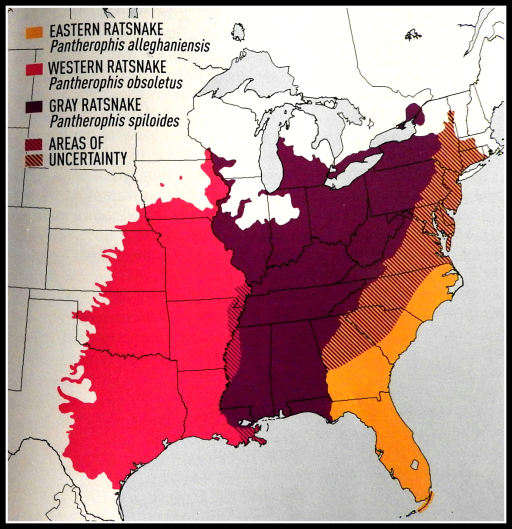
(map from Peterson Field Guide to Reptiles and Amphibians of Eastern and Central North America, 4th edition)
…and the old range map
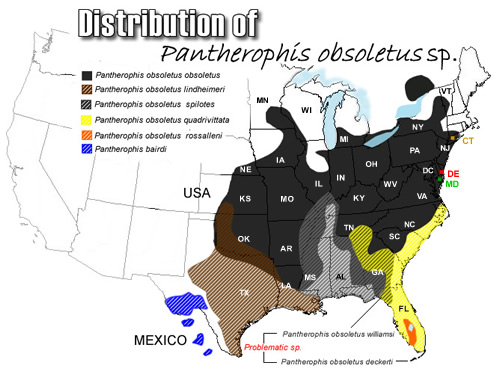
(map from ratsnakefoundation.org)
Well, as you might have guessed, this revision got everyone all upset ; biologists, enthusiasts, lawyers, doctors, celebrity chefs…whoever! Many of those people are stubborn and chose to not accept it, well, because, they just didn’t like it. Still others examined the science and concluded that the authors did not do enough “sampling” to make this kind of decision. (sampling means examining a certain number of snake DNA from all portions of the range).
Despite the rumblings, the two main herpetology groups in North America have accepted the new ratsnake taxonomy. (CNAH and SSAR, respectively). Still, people are stubborn, and many websites and books are still using the older taxonomy. Regardless of which side of the fence you may fall, this causes mass confusion for those who know nothing about snakes and are just starting to learn. Perhaps the most confusing aspect of all is the appearance of these snakes. Take this for example :
Under the new taxonomy, this snake…
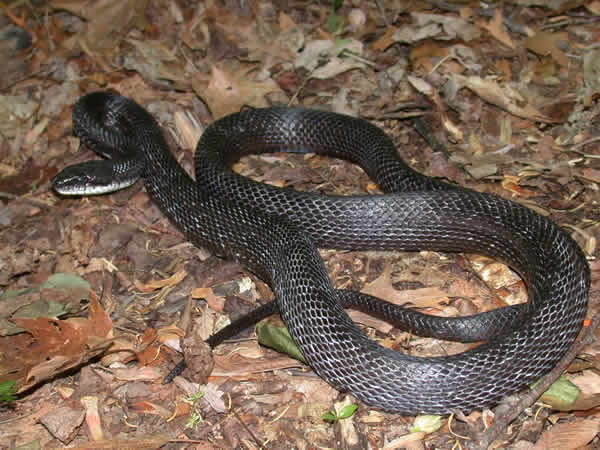
photo © J.D. Willson
…and this snake
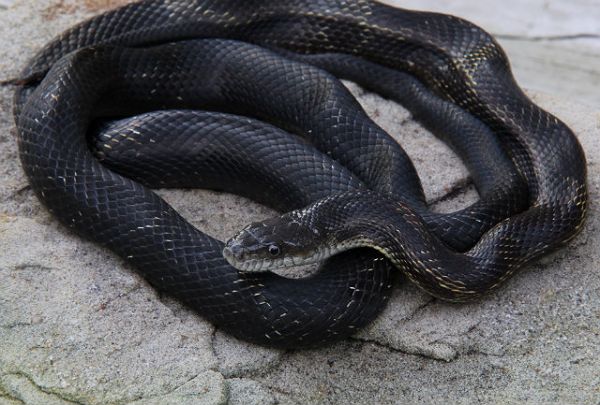
photo © Tim Spuckler
..are two different species. One is from North Carolina (Eastern Ratsnake), and the other is from Ohio (Gray Ratsnake). I’ll let you decide which is which! All of those lovely yellow, black, gray, and everglades ratsnakes on the east coast? Those are all now considered color variants of one species (eastern ratsnake), and out west, the colorful Texas ratsnakes and the more drab ratsnakes from Missouri and Iowa, for example, are variants of the western ratsnake. The point is, although there may be some small physical differences under examination, many of these snakes, to the average person, look exactly the same.
Key Points
- The three species, which used to be one, are separated by geography and in order to get a definitive identification we must learn the ranges according to the updated map.
- The main confusion arises from the fact that these snakes can look very similar despite being separate species.
- many publications and websites are still using the old taxonomy.
For the record, I am not taking sides here in this blog post. That is not my intention. My only intention is that you gain a better understanding of the “ratsnake mess” that may continue to plague us into the foreseeable future. I leave it up to you to decide which taxonomy to accept.
If you still have questions, please join us and ask the Facebook group –
Wild Snakes : Education & Discussion
One more thing – my article covers only the ratsnake that was split into three species. All other species of Ratsnake (Pantherophis) are not covered here, and remain untouched. This includes the Cornsnake (Pantherophis guttatus), Baird’s Ratsnake (Pantherophis bairdi), among others.
this blog entry is geared toward the average person who is trying to understand ratsnake taxonomy. What this is NOT meant to be is a technical taxonomy paper. There is plenty more to learn about the history of ratsnakes in North america, and the long list of former nomenclature (scientific names). I have not covered every minute detail here and I didn’t intend to. Thanks for reading.
And where does the Trans Pecos ratsnake fit in?
LikeLike
The Trans-Pecos Ratsnake (Bogertophis subocularis) is in a separate genus (Bogertophis), and is not included in any of the Pantherophis revisions. It remains a stand-alone genus that happen to also be referred to as “ratsnakes”.
LikeLike
Will you be writing something about the recent changes with king snakes (black, eastern chain, speckled…) as well?
LikeLike
Yes. That will be my next entry.
LikeLike
Nice job & informational to us idiots who are learning👍🏼
LikeLike
Thank you for that clear and concise explanation! But what about the Fox Snakes? They are currently in the Pantherophis genus! Where do they fit into all this? Just as an observation, they almost seem like a pituophis to me!
LikeLike
All other Pantherophis species remain untouched.
LikeLike
Sort of. The foxsnakes have their own weird story, in some ways even weirder than this one. There used to be two species: the western foxsnake (formerly P. vulpinus) being found in the USA between the Missouri River and Lake Michigan, separated by a foxsnake-less area in northeastern Indiana and the lower peninsula of Michigan from the eastern foxsnake (formerly P. gloydi), which was found south and east of Lake Huron in Ontario, Michigan, and Ohio. However, a 2011 study used evidence from a single mitochondrial gene to suggest that the Mississippi River seemed to be a more significant genetic barrier and that western foxsnakes east of the Mississippi in Wisconsin and Illinois were more closely related to eastern foxsnakes than they were to western foxsnakes in Iowa and Minnesota. Because the type specimens for both former foxsnake species were within the eastern lineage, this species became P. vulpinus (the older name), P. gloydi disappeared, and the “new” western foxsnake was named P. ramspotti.
Click to access crother2011.pdf
LikeLike
And, there was a proposal to combine Pituophis and Pantherophis for a time, because one study found that some Pantherophis were more closely related to Pituophis than they were to other Pantherophis; this didn’t really catch on, and as far as I know no other study has since replicated that result.
LikeLike
What’s the difference in the Ratsnake and the Chickensnake!
LikeLike
“Chicken Snake” is just a colloquial (local) name for ratsnakes in some parts of the U.S. They are also known as a “Cow Snake” in some places, such as Kentucky.
LikeLike
I always heard, growing up in North Carolina, that a “chicken snake” was a yellow ratsnake (then E. o. quadrivittata) and a “pilot snake” was a black ratsnake (then E. o. obsoleta). But, I’m sure it differs from place to place.
LikeLike
I’m not particularly interested in taxonomy. My FB friend shared/liked this blog post so I read it. I found it concise, funny, and I almost filled everything. I’m in the woods a lot, so I’ll keep an eye out for all the snakes and give them the respect they deserve. I hope to never get bitten by a snake but would understand it if I did. I hope the kids I take out into the woods don’t get bitten. If you ever want to blog sort of “random tips for avoiding snakes while walking in the woods” that would be great. For example, someone once told me to always step in a log, and look over the other side before stepping over. Anyway, nice blog. Go snakes.
LikeLiked by 1 person
Thanks for the idea, and thanks for reading.
LikeLike
I could have written this post, but you did before i got to it! Yes, snake avoidance tips would be helpful. i am not as terrified of snakes as i used to be from both visiting snake ed sites and from realizing that snakes actually rarely bite humans who are not bothering them, but i still don’t want to accidentally get in a position where a snake bites me. so make that 2 requests for that blog.
LikeLike
Personally I think it’s BS that they’ve just lumped all the species into one another and if we know anything about anything that some rich person is probably behind these taxonomy changes. Now all the endangered and threatened subspecies are just “Some rat snake” which is not protected and now development projects can proceed as planned. You’ll notice that they just changed around all of the king snake species as well, makes you think. Did we really just have all these different snakes and then randomly decide they are all the same damn thing? I think not.
A similar DNA sampling study almost combined gophersnakes/bullsnakes and rat snakes back in the day. Didn’t catch on because it’s stupid. If the Everglades/Yellow Rat Snake and a corn snake were the same species then you wouldn’t find distinct examples of each in the exact same place in the wild. And this study was criticized for not sampling enough data to draw the conclusions that they have.
LikeLike
The Cornsnake (Pantherophis guttatus) remains it’s own species and wasn’t included in this revision.
LikeLike
I caught breeding rats in eastern MA in Bristol county. State herpetologist confirmed. I wonder how we could extend the range map to go east of Connecticut river valley?
LikeLike
You have to get range extensions published in a journal, and then the authors of field guides need to be aware of them. It’s a bit of a process.
LikeLike
Thanks! I am showing my ignorance, but i have a lot of it to show. two things, one can species interbreed? if so, what makes them different species and how do they keep their DNA separated?
And two, because it is an issue that resonates with me, if an eastern rat snake can be gray, black, dusky or orange/yellow, and still be one species, that really seems to reinforce the fact that humans of every shade and shape are truly one species and dividing them up into races is just ignorant and anti science…. not wanting to throw politics and race into the issue except as it applies to science.
LikeLike
Species can interbreed, and there are several examples of wild hybrid snakes. They are certainly not common but a famous example is the Banded Watersnake (Nerodia fasciata) and the Atlantic Salt Marsh Snake (Nerodia clarkii) that occur in many areas of Florida. Here is a great page that explains (or tries to) how we define species.
https://evolution.berkeley.edu/evolibrary/article/0_0_0/evo_41
Snakes are not humans, and their patterns and colors are influenced by environmental factors and millions of years of evolution.
LikeLike
Pingback: 50 Shades of “Gray” Rat Snake – floridensis
Same thing recently happened with eastern indigos. There are now two separate species.
Same thing happened to Macroclemys. There are now 3 species, instead of just temminckii
LikeLike
Excellent article. Great job putting at the classifcation chaos into laymans terms. I referenced your article on my blog at http://williamwisephoto.com/photographyblog/eastern-rat-snake-walton-georgia. Glad I came across your blog. Look forward to digging in a bit. William http://www.williamwisephoto.com.
LikeLike
Thanks for reading!
LikeLike